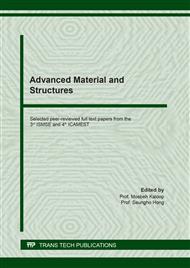[1]
Garret EH. Fresh-cut produce: tracks and trends. In: Lamikanra O, editor. Fresh-cut fruitsand vegetables: science, technology, and market. Boca Raton (2002) 21–29.
DOI: 10.1201/9781420031874.ch1
Google Scholar
[2]
R.C. McKellar, J. Odumeru, T. Zhou, A. Harrison, D.G. Mercer, J.C. Young, X. Lu, J. Boulter, P. Piyasena, S. Karr, Influence of a commercial warm chlorinated water treatment and packaging on the shelf-life of ready-to-use lettuce, Food Res Int 37 (2004) 343–54.
DOI: 10.1016/j.foodres.2004.02.002
Google Scholar
[3]
M. Montero-Calder´on, M.A. Rojas-Gra¨u, O. Mart´ın-Belloso Effect of packaging conditions on quality and shelf-life of fresh-cut pineapple (Ananas comosus), Postharv Biol Technol 50 (2008) 182–9.
DOI: 10.1016/j.postharvbio.2008.03.014
Google Scholar
[4]
G. Oms-Oliu, R. Soliva-Fortuny, O. Martin-Belloso, Edible coatings with antibrowning agents to maintain sensory quality and antioxidant properties of fresh-cut pears, Postharvest Biol. Tec. 50 (2008) 87–94.
DOI: 10.1016/j.postharvbio.2008.03.005
Google Scholar
[5]
V. Chiabrando, G. Giacalone, Effect of essential oils incorporated into an alginate-based edible coating on fresh-cut apple quality during storage, Qual. Assur. Saf. Crop 7 (2015) 251–259.
DOI: 10.3920/qas2013.0337
Google Scholar
[6]
B. Salinas-Roca, R. Soliva-Fortuny, J. Welti-Chanes, O. Martín-Belloso, Combined effect of pulsed light, edible coating and malic acid dipping to improve fresh-cut mango safety and quality, Food Control 66 (2016) 190–197.
DOI: 10.1016/j.foodcont.2016.02.005
Google Scholar
[7]
C. Costa, A. Conte, G.G. Buonocore, M. Lavorgna, M.A. Del Nobile, Calcium alginate coating loaded with silver-montmorillonite nanoparticles to prolong the shelf-life of fresh-cut carrots, Food Res. Int. 48 (2012) 164–169.
DOI: 10.1016/j.foodres.2012.03.001
Google Scholar
[8]
L. Salvia-Trujillo, M.A. Rojas-Graü, R. Soliva-Fortuny, O. Martín-Belloso, Use of antimicrobial nanoemulsions as edible coatings: Impact on safety and quality attributes of fresh cut fuji apples, Postharvest Biol. Tec. 105 (2015) 8–16.
DOI: 10.1016/j.postharvbio.2015.03.009
Google Scholar
[9]
M.A. Rojas-Grau, M.S. Tapia, F.J. Rodriguez, A.J. Carmona, O. Martin-Belloso, Alginate and gellan-based edible coatings as carriers of antibrowning agents applied on fresh-cut Fuji apples, Food Hydrocoll. 21 (2007) 118–127.
DOI: 10.1016/j.foodhyd.2006.03.001
Google Scholar
[10]
M.S. Tapia, M.A. Rojas-Grau, A. Carmona, F.J. Rodriguez, R. Soliva-Fortuny, O. Martin Belloso, Use of alginate- and gellan-based coatings for improving barrier, texture and nutritional properties of fresh-cut papaya, Food Hydrocoll. 22 (2008) 1493–1503
DOI: 10.1016/j.foodhyd.2007.10.004
Google Scholar
[11]
G.A. Gonzalez-Aguilar, E. Valenzuela-Soto, J. Lizardi-Mendoza, F. Goycoolea, M.A. Martínez-Téllez, M.A. Villegas-Ochoa, I.N. Monroy-Garcia, J.F. Ayala-Zavala, Effect of chitosan coating in preventing deterioration and preserving the quality of fresh-cut papaya 'Maradol', J. Sci. Food Agric. 89 (2009) 15–23.
DOI: 10.1002/jsfa.3405
Google Scholar
[12]
M.R. Moreira, S.I. Roura, A. Ponce, Effectiveness of chitosan edible coatings to improve microbiological and sensory quality of fresh cut broccoli, LWT-Food Sci. Technol. 44 (2011) 2335–2341.
DOI: 10.1016/j.lwt.2011.04.009
Google Scholar
[13]
L.V. Raymond, M. Zhang, S.M.R. Azam, Effect of chitosan coating on physical and microbial characteristics of fresh-cut green peppers (Capsicum annuum L.), Pak. J. Nutr. 11 (2012) 806–811.
DOI: 10.3923/pjn.2012.904.909
Google Scholar
[14]
H.Q. Dong, L. Cheng, J. Tan, K. Zheng, Y. Jiang, Effects of chitosan coating on quality and shelf life of peeled litchi fruit, J. Food Eng. 64 (2004) 355–358.
DOI: 10.1016/j.jfoodeng.2003.11.003
Google Scholar
[15]
M.K. Saba, O.B. Sogvar, Combination of carboxymethyl cellulose-based coatings with calcium and ascorbic acid impacts in browning and quality of fresh-cut apples, LWT-Food Sci. Technol. 66 (2016) 165–171.
DOI: 10.1016/j.lwt.2015.10.022
Google Scholar
[16]
B. Yousuf, A.K. Srivastava, A novel approach for quality maintenance and shelf life extension of fresh-cut Kajari melon: Effect of treatments with honey and soy protein isolate, LWT-Food Sci. Technol. 79 (2017) 568–578.
DOI: 10.1016/j.lwt.2016.11.005
Google Scholar
[17]
R.M. Geraldine, N.F.F. Soares, D.A. Botrel, L.A. Goncalves, Characterization and effect of edible coatings on minimally processed garlic quality, Carbohydr. Polym. 72 (2008) 403–409.
DOI: 10.1016/j.carbpol.2007.09.012
Google Scholar


